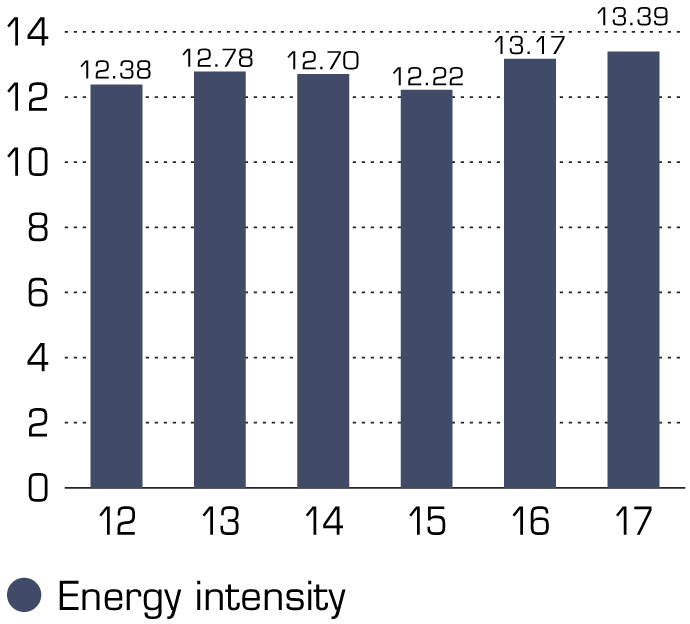Material Topic: Energy
302–1 Energy consumption within the organisation
Energy consumption in 2017 totalled 19.8 (19.1) million gigajoules (GJ). Electricity accounts for 16.5 (16.1) million GJ of this consumption, which equates to 4.6 (4.5) TWh.
The reported energy usage is based on invoiced incoming and outgoing deliveries, supplemented by internal measurements and stock inventories at the end of the year. Conversions between weight and energy have been performed using energy values specified by the supplier or by using tabled values provided by national bodies.
Coke, coal, oil, and fuel gases are used for the reduction and smelting of copper, lead, and zinc concentrates. Diesel is used for transportation purposes, in mining operations, and for internal transportation. Limited amounts of heating oil and gas are used for heating purposes during the cold season. The use of biofuels in metallurgical processes has been tested and evaluated, but has, up to now, been negligible in the larger context. A boiler based on biomass has been added during the reporting period. Bio-based fuels have also, to a limited extent, been used in road transports. Electricity is the dominant source of indirect energy in the Group. Out of the total indirect energy used, 97% comprises electricity and only 3% is purchased heat.
|
Direct Energy |
2015 |
2016 |
2017 |
|
Coal & coke |
1,757,000 |
1,743,000 |
1,844,000 |
|
Gas |
395,000 |
446,000 |
289,000 |
|
Oil |
1,187,000 |
1,794,000 |
2,128,000 |
|
Diesel & petrol |
1,692,000 |
1,689,000 |
1,611,0001) |
|
Other |
– |
13,000 |
36 ,000 |
|
Total renewable energy |
– |
29,000 |
51,000 |
|
Total energy |
5,031,000 |
5,686,000 |
5,908,000 |
|
Electricity, purchased |
14,635,000 |
16,080,000 |
16,524,000 |
|
Heat, purchased |
381,000 |
453,000 |
501,000 |
|
Gross energy input |
20,047,000 |
22,218,000 |
22,934,000 |
|
Produced energy, |
2,117,000 |
2,205,000 |
2,291,000 |
|
Produced energy, sold |
3,234,000 |
3,157,000 |
3,146,000 |
|
Net energy used |
16,813,000 |
19,061,000 |
19,788,000 |
1) Whereof 15,000 GJ disel from renewable sources
Energy input, 2017 per source
The gross energy input is 22,934,000 (22,218,000) GJ for the year.

302–3 Energy intensity
Boliden’s energy intensity was 13.39 (13.17) GJ/t metal, an increase from the previous year. The energy intensity ratio is reported as the product intensity (energy consumed per unit produced). It is calculated as Boliden’s net total energy consumption (same as in GRI 302-1 for all Boliden sites divided by the production output in metal tonnes from Boliden production sites. This indicator is affected both by process efficiency and the product mix and raw material properties. The intensity increase in the reporting year is due to the business unit (Kevitsa) being fully integrated in the reporting.
Energy intensity
GJ/t metal

302–4 Reduction of energy consumption
Boliden has implemented routines for purchasing high-consumption electrical equipment and procedures for the evaluation of life-cycle costs in construction and renovation as important parts of its ISO certified energy management systems. Because of the different character of mining and smelting operations, Boliden has chosen to work with local energy targets instead of Group targets.
In its mining operations, Boliden has put a lot of effort into reducing the energy used for ventilation (electric energy) and heating (oil or propane) of its underground mines. In a ‘Ventilation on Demand’ project at the Kankberg mine in the Boliden area, commissioned in 2016, electrical consumption was reduced by 54% and the propane consumption by 21%. Ventilation on Demand means that the ventilation is real-time adjusted depending on where people and machines are working in the mine. Large energy reductions could be accomplished without impairing the working environment.
In its smelting operations, Boliden strives to take advantage of excess heat from the processes, transforming it either to electric power or supplying it for use in external district heating or steam deliveries. In 2017, 2,291,000 (2,205,000) GJ of heat was used internally, and 3,146,000 (3,157,000) GJ was delivered externally for use in district heating systems.
